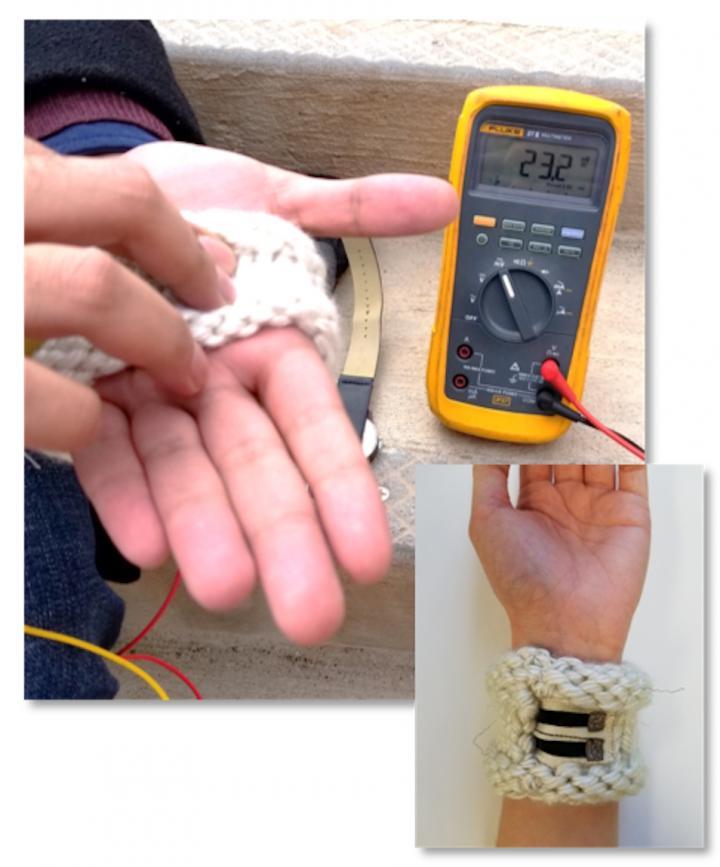These Scientist Can Help You Make Electricity From Your Own Body Heat
Indira Datta - Apr 30, 2019

Researchers from the University of Massachusetts have developed a low-cost method of using human body heat to power wearables.
- IIT Mandi Researchers Develop Road That Can Generate Electricity By Walking
- Our Future Smartphones Can Be Charged With Electricity Produced Out Of Thin Air
- This New Method Can Generate Enough Energy To Power 100 LED Lights From One Drop Of Rain
Researchers at the University of Massachusetts have created a fabric capable of collecting the amount of heat emitted in the body and converting it into energy to provide small and light devices such as body monitors.
Materials chemist Trisha Andrew has developed many biosensors, data transmitters and similar technology devices for personal health monitoring, but it always needs a lot of power and bulky. Recently, she and her Ph.D. student Linden Allison has successfully developed a fabric capable of absorbing heat in the human body and supplying electricity to small devices.

The flexible and affordable fabric can convert body heat into usable energy.
Andrew and Allison have explained how it works that the difference between the ambient temperature and the cool air of the surrounding environment can cause them to generate electricity, which we can call "thermal effects. ". Thus, materials with high thermal conductivity and low thermal conductivity can bring a charge from warm areas to colder regions. Since then, scientists have suggested that the temperature from the human body could become a small source of electricity, but still enough to supply wearable devices.
Our body always emits heat itself so the energy it brings is infinite. And the fabrics used to absorb and metabolize this energy source do not bring any harm or cost to humans and the environment.
The main material is a cheap flexible polymer film and is compatible with steam printing biology, and it is pretty abundant on cotton fabric. What makes this fabric the choice of researchers is due to its high thermal properties, which produce quite a high voltage enough to carry energy for a small device to work.
A natural characteristic of cotton and wool is its low thermal transport which has been utilized by the two scientists and incorporated into thermoelectric garments, making it possible to stabilize the thermal tendency on an electric device, which is called thermoelectricity.
That allows it to convert electrical energy while wearing a long time. The two researchers added that the basic insulating properties in the fabric to solve long-standing problems in the device community.

Heat in the human body can power some types of small electrical equipment thanks to this fabric.
The researchers used vapor-printing to create p-doped poly (3,4-ethylenedioxythiophene) (PEDOT-Cl) - this is a polymer back on a shuttle fabric and a medium textile, from there they created a completely electric thermal fabric. When wearing this fabric in our hands through a specially designed strip, they can provide a current greater than 20 milliVolts.
The durability of the PEDOT-Cl coating was also tested by the researchers through scrubbing and washing in warm water, after which they evaluated its performance through an electronic microwave scanner. As a result, the coating has no damage, cracked or erased. This shows that PEDOT-CI vapor-printing technology is reliable. Andrew and Allison also said that the conductivity of both experimental fabrics did not change after the cleaning and washing process.
Humid materials are often better in transferring heat than dry materials, so when we are more active and sweatier than usual, the amount of energy supplied to the device will be much higher. Scientists have controlled this problem by inserting a heat-reflective plastic layer between the wearer's skin and the skin to keep the heat transferred in a stable manner.
The two researchers also added with Advanced Materials Technologies (the paper published this study) that their research brings a mechanically certain view of the operability of the efficiency of vapor printing with PEDOT-CI creates completely thermoelectric fabric. In addition, the study has also demonstrated the harmlessness of this fabric for wearers during long-term use.
In addition, research could bring out various clothes with electronic wearable devices that will be more affordable.
Featured Stories

Features - Jul 01, 2025
What Are The Fastest Passenger Vehicles Ever Created?

Features - Jun 25, 2025
Japan Hydrogen Breakthrough: Scientists Crack the Clean Energy Code with...

ICT News - Jun 25, 2025
AI Intimidation Tactics: CEOs Turn Flawed Technology Into Employee Fear Machine

Review - Jun 25, 2025
Windows 11 Problems: Is Microsoft's "Best" OS Actually Getting Worse?

Features - Jun 22, 2025
Telegram Founder Pavel Durov Plans to Split $14 Billion Fortune Among 106 Children

ICT News - Jun 22, 2025
Neuralink Telepathy Chip Enables Quadriplegic Rob Greiner to Control Games with...

Features - Jun 21, 2025
This Over $100 Bottle Has Nothing But Fresh Air Inside

Features - Jun 18, 2025
Best Mobile VPN Apps for Gaming 2025: Complete Guide

Features - Jun 18, 2025
A Math Formula Tells Us How Long Everything Will Live

Features - Jun 16, 2025
Comments
Sort by Newest | Popular